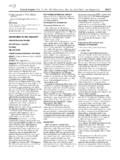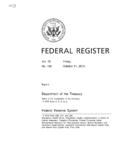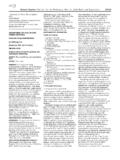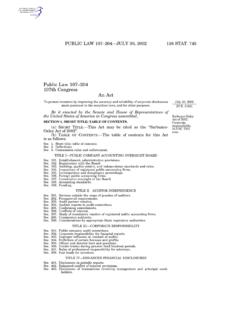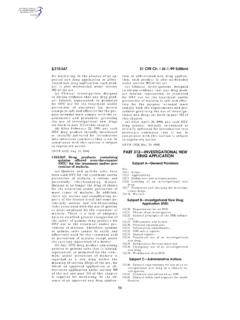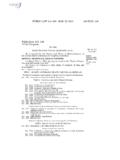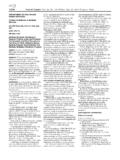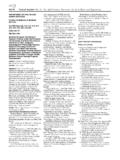Transcription of FISCAL YEAR 2016 HISTORICAL TABLES
1 HISTORICALTABLESBUDGET OF THE GOVERNMENTFISCAL year OF MANAGEMENT AND BUDGETScan here to go to our NOTES1. All years referenced for budget data are FISCAL years unless otherwise noted. All years refer-enced for economic data are calendar years unless otherwise noted. 2. Detail in this document may not add to the totals due to At the time the President s 2016 Budget request was developed, the 2015 Department of Homeland Security Appropriations bill was not enacted; therefore, the discretionary programs and activities normally provided for in the full- year appropriations bill were operating under a continuing resolution (Public Law 113-235, Division L). For those programs and activities, full- year appropriations data included in the current year column (2015) in the budget Appendix, and in TABLES that show details on discretionary spending amounts in the Analytical Perspectives volume, reflect the annualized level provided by the continuing resolution.
2 In the main Budget volume and the online HISTORICAL TABLES volume, current year totals by agency and for the total Government match the President s 2015 Budget : The information contained in this PDF file is identical to the informationcontained in the HISTORICAL TABLES files published on February 2, TO THE HISTORICAL TABLES STRUCTURE, COVERAGE, AND CONCEPTS HISTORICAL TABLES provides a wide range of data on Federal Government finances. Many of the data series begin in 1940 and include estimates of the President s Budget for 2015 2020. Additionally, table provides data on receipts, outlays, and surpluses or deficits for 1901 1939 and for earlier multiyear periods. Structure This document is composed of 16 sections, each of which has one or more TABLES . Each section covers a common theme. Section 1, for example, provides an overview of the budget and off-budget totals; Section 2 provides TABLES on receipts by source; and Section 3 shows outlays by function.
3 When a section contains several TABLES , the general rule is to start with TABLES showing the broadest overview data and then work down to more detailed TABLES . The purpose of these TABLES is to present a broad range of HISTORICAL budgetary data in one convenient reference source and to provide relevant comparisons likely to be most useful. The most common comparisons are in terms of proportions ( , each major receipt category as a percentage of total receipts and of the gross domestic product). Section notes explain the nature of the activities covered by the TABLES in each section. Additional descriptive information is also included where appropriate. Explanations are generally not repeated, but there are occasional cross-references to related materials. Because of the numerous changes in the way budget data have been presented over time, there are inevitable difficulties in trying to produce comparable data to cover many years. The general rule is to provide data in as meaningful and comparable a fashion as possible.
4 To the extent feasible, the data are presented on a basis consistent with current budget concepts. When a structural change is made, insofar as possible the data are adjusted for all years. One significant change made in the early 1990s concerns the budgetary treatment of Federal credit programs, which was changed by the Federal Credit Reform Act of 1990. Previously the budget recorded the cost of direct and guaranteed loans on a cash basis. Under credit reform, the budget records budget authority and outlays for the subsidy cost of direct and guaranteed loans made in 1992 and subsequent years. The subsidy is defined as the net estimated cash flows to and from the Government over the life of the loan, discounted to the present. The remaining cash transactions of credit programs are recorded as a means of financing the deficit. Because it is impossible to convert the pre-1992 loans to a credit reform basis, the data are on a cash basis for pre-1992 loans and on a credit reform basis for loans made in 1992 and subsequent years.
5 Coverage The Federal Government has used the unified or consolidated budget concept as the foundation for its budgetary analysis and presentation since the 1969 budget. The basic 1 guidelines for the unified budget were presented in the Report of the President s Commission on Budget Concepts (October 1967). The Commission recommended the budget include all Federal FISCAL activities unless there were exceptionally persuasive reasons for exclusion. Nevertheless, from the very beginning some programs were perceived as warranting special treatment. Indeed, the Commission itself recommended a bifurcated presentation: a unified budget composed of an expenditure account and a loan account. The distinction between the expenditure account and the loan account proved to be confusing and caused considerable complication in the budget for little benefit. As a result, this distinction was eliminated starting with the 1974 Budget.
6 However, even prior to the 1974 Budget, the Export-Import Bank had been excluded by law from the budget totals, and other exclusions followed. This exclusion resulted in two new budget terms, on-budget and off-budget, to distinguish between these excluded entities and the rest of the budget. Although there is a legal distinction between on-budget and off-budget entities, there is no conceptual difference between the two. The off-budget Federal entities engage in the same kinds of governmental activities as the on-budget entities, and the programs of off-budget entities result in the same kind of outlays and receipts as on-budget entities. Like on-budget entities, off-budget entities are owned and controlled by the Government. The unified budget reflects the conceptual similarity between on-budget and off-budget entities by showing combined totals of outlays and receipts for both types of entities. The Balanced Budget and Emergency Deficit Control Act of 1985 (Public Law 99 177) repealed the off-budget status of all then existing off-budget entities, but it also included a provision moving the Federal old-age, survivors, and disability insurance funds (collectively known as Social Security) off-budget.
7 To provide a consistent time series, the budget HISTORICAL data show Social Security off-budget for all years since its inception, and show all formerly off-budget entities on-budget for all years. The Omnibus Budget Reconciliation Act of 1989 (OBRA 1989) moved the Postal Service fund off-budget, starting in 1989. Again to provide a consistent time series, transactions of the Postal Service fund are shown off-budget beginning with its inception in 1972. The transactions of its predecessor, the Post Office Department, remain on-budget. Though Social Security and the Postal Service are now off-budget, they continue to be Federal programs. Indeed, Social Security currently accounts for about one-fourth of all Federal receipts and one-fifth of all Federal spending. Hence, the budget documents include these funds and focus on the Federal totals that combine the on-budget and off-budget amounts. Various budget TABLES and charts show total Federal receipts, outlays, and surpluses and deficits, and divide these totals between the portions that are on-budget and off-budget.
8 Changes in HISTORICAL Budget Authority, Outlays, Receipts, and Deficits This year s annual consultations with the Congress regarding reclassification of accounts or activities as to function or subfunction resulted in the reclassification of four items. The Outreach and Assistance for Socially Disadvantaged Farmers, in the Department of Agriculture s Office of the Secretary account was reclassified from subfunction 351 (Farm Income Stabilization) to subfunction 352 (Agricultural research and services). This program has mostly involved the 2 provision of additional services to select groups and is, therefore, more appropriately classified as subfunction 352. The Detention Trustee program in the Department of Justice was reclassified from subfunction 753 (Federal correctional activities) to subfunction 752 (Federal litigative and judicial activities) to correct a technical error in the functional classification. The account supports activities related to the detention of Federal prisoners in non-Federal institutions or otherwise in the custody of the United States Marshals Service and the detention of aliens in the custody of the Immigration and Naturalization Service.
9 The 2014 transfer of balances of the Environmental Protection Agency s Leaking Underground Storage Tank Trust Fund to the Department of Transportation s Highway Trust Fund was reclassified as subfunction 401 (Ground transportation) rather than subfunction 304 (Pollution control and abatement), the normal subfunction for this account, to properly reflect the effects of this transfer by subfunction. A 1998 transaction in the Medicare Payment Advisory Commission in the Legislative Branch was reclassified from subfunction 551 (Health care services) to subfunction 571 (Medicare) to correct a technical error. Adjustments have also been made to reflect corrections in agency reporting provided to the Treasury Department. Note on the FISCAL year The Federal FISCAL year begins on October 1 and ends on the subsequent September 30. It is designated by the year in which it ends; for example, FISCAL year 2014 began on October 1, 2013, and ended on September 30, 2014.
10 Prior to FISCAL year 1977 the Federal FISCAL years began on July 1 and ended on June 30. In calendar year 1976 the July-September period was a separate accounting period (known as the transition quarter or TQ) to bridge the period required to shift to the new FISCAL year . Note on Proposed Reclassification of Certain Programs The Budget includes a proposal to change the financing of certain ground transportation programs, which would result in the reclassification of certain activities as to Budget Enforcement Act (BEA) categories. The proposed reclassification would not take effect until 2016 , but, for purposes of comparability, the Budget estimates show the category reclassifications starting in 2014. TABLES in this document that display Budget Enforcement Act (BEA) categories reflect these reclassifications as starting in 2015 in order to show the actual categorization for 2014. As a result, discretionary and mandatory category totals for 2015 and beyond are not fully comparable with corresponding totals for 2014 and prior years.
